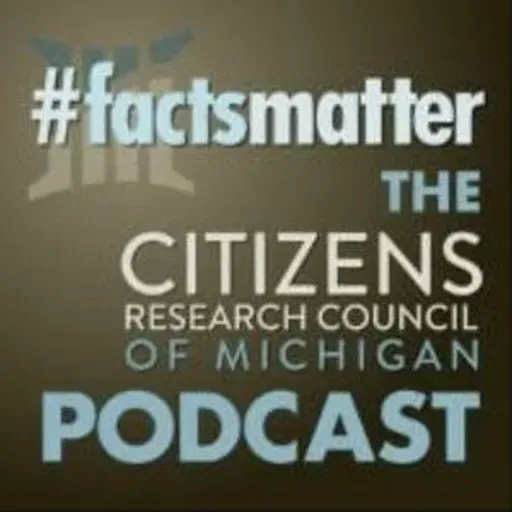
25 April 2024
Enrollments Are Down, Federal Pandemic Cash is Ending: Are MI Schools Facing a COVID Funding Cliff?
#FactsMatter, the Citizens Research Council of Michigan podcast
About
There are many tough decisions on the horizon for Michigan school districts.
Schools are facing massive sums of federal pandemic relief funds ending at the same time that many they are facing declining enrollment, partially also due to the pandemic.
Approximately 50% of K-12 budgets are allocated on staff salaries, with another 20% to 30% allocated for benefits. Added together, salaries and benefits – people -- account for about $4 out of every $5 dollars in school budgets, spread across a variety of programs.
Not surprisingly, many, many districts used the additional resources to grow their staffing, leading to what will now be exceedingly tough decisions on staffing levels.
Bridge Michigan education speaks with Council Research Director Craig Thiel about his recent papers on this imminent, critical issue and what we can expect from school district budgets for the coming year. They discuss how districts programmed federal (and state) pandemic resources over the last three years as they crafted their budgets. They speculate about the number of districts who accounted for the limitations of the one-time federal funding and that the federal deadline for allocating it all is this September.
They also discuss how parents and members of school communities can get involved and get engaged in the process. This includes everything from reviewing and looking for spending red flags in public documents online, such as schools’ budgets past and present, as well as financial statements, to attending their local school board meetings where budgets get adopted. Even better: attending their local school or district finance committee or budget committee meeting, where budget proposals are crafted.
Other “red flag” warnings in budgets include a reliance on Rainy Day funds to support operations. While this is justifiable when needed – to transition to a new budget norm – Rainy Day funds are not designed to support ongoing programming in a district because those one-time resources will run out too.
Districts with stronger Rainy Day fund balances will not have as many, if any, painful cuts. Those that don’t have a robust Rainy Day fund and used federal pandemic resources for ongoing costs are going to be challenged.
For example: districts that allocated pandemic funds to one-time programming or services – facility upgrades, equipment and curricula purchases – will not face as many, if any, painful cuts.
Schools are facing massive sums of federal pandemic relief funds ending at the same time that many they are facing declining enrollment, partially also due to the pandemic.
Approximately 50% of K-12 budgets are allocated on staff salaries, with another 20% to 30% allocated for benefits. Added together, salaries and benefits – people -- account for about $4 out of every $5 dollars in school budgets, spread across a variety of programs.
Not surprisingly, many, many districts used the additional resources to grow their staffing, leading to what will now be exceedingly tough decisions on staffing levels.
Bridge Michigan education speaks with Council Research Director Craig Thiel about his recent papers on this imminent, critical issue and what we can expect from school district budgets for the coming year. They discuss how districts programmed federal (and state) pandemic resources over the last three years as they crafted their budgets. They speculate about the number of districts who accounted for the limitations of the one-time federal funding and that the federal deadline for allocating it all is this September.
They also discuss how parents and members of school communities can get involved and get engaged in the process. This includes everything from reviewing and looking for spending red flags in public documents online, such as schools’ budgets past and present, as well as financial statements, to attending their local school board meetings where budgets get adopted. Even better: attending their local school or district finance committee or budget committee meeting, where budget proposals are crafted.
Other “red flag” warnings in budgets include a reliance on Rainy Day funds to support operations. While this is justifiable when needed – to transition to a new budget norm – Rainy Day funds are not designed to support ongoing programming in a district because those one-time resources will run out too.
Districts with stronger Rainy Day fund balances will not have as many, if any, painful cuts. Those that don’t have a robust Rainy Day fund and used federal pandemic resources for ongoing costs are going to be challenged.
For example: districts that allocated pandemic funds to one-time programming or services – facility upgrades, equipment and curricula purchases – will not face as many, if any, painful cuts.